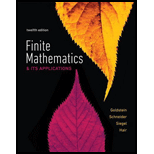
Concept explainers
Distributing Books Fred has 12 different books.
(a) Suppose that Fred first gives three books to Jill and then gives four of the remaining books to Jack. How many different outcomes are possible?
(b) Suppose that Fred first gives four books to Jack and then gives three of the remaining books to Jill. How many different outcomes are possible?
(c) Explain why the answers to parts (a) and (b) are the same.
Trending nowThis is a popular solution!

Chapter 5 Solutions
Finite Mathematics & Its Applications (12th Edition)
Additional Math Textbook Solutions
Pathways To Math Literacy (looseleaf)
Calculus: Early Transcendentals (2nd Edition)
Elementary Statistics ( 3rd International Edition ) Isbn:9781260092561
Elementary Statistics
Finite Mathematics for Business, Economics, Life Sciences and Social Sciences
Probability And Statistical Inference (10th Edition)
- 2 Solve for (x, y, z) in the set of linear, inhomogeneous equations: 2x+5y + z = 2 x+y+2x=1 2+52=3.arrow_forwardProve by induction that for any natural number N, 1 N Σ42 = 6 N(N + 1)(2N + 1). k=1 Indicate clearly where you use the inductive hypothesis.arrow_forward2x-y=1 x+2y=7 y = 2x + 2 3x + 2y = 4 x+3y=0 x-3y=6 8 4x-2y=7 x + 3y = 7 10 2x-2y=5 2x + 3y+ 1 = 0 Ke int lin Chapter 14arrow_forward
- (a) (b) Let A, B be disjoint subsets of a set X. Show that AC Bc. Use proof by contradiction to show that for any a, b = R, if a is rational and b is irrational then ba is irrational.arrow_forward(d) Consider the sequences (xn), (yn) defined recursively as follows: Xn+1 = xn2yn, i. ii. n, Yn+1=Yn2xn for n ≥ 1, x1 = 1, y₁ = 2. Calculate x2, y2 and x3, Y3. - Show using induction or otherwise that for any natural number - Xn+Yni = (1+2i)". Hence or otherwise, show that for any natural number n, iii. Zn = (V5)” cos(n arctan2), n = (V5)” sin(n arctan 2).arrow_forward2. (a) For each of the following functions, decide whether it is injective, and whether it is surjective. Justify your answers. i. f: Z → 22 Z 3z +1 ii. 9: C→ 22 Re(z) + Im(z)arrow_forward
- Not use ai pleasearrow_forward2. Given f(0) = (2 cos 0)² - 3sin²0. 1 a. Show that f(0) = ½ + ½ 7 + - cos cos 20. 2 2 b. Hence, find the exact value of √² 0 ƒ (0) do.arrow_forward2. Given f(0) = (2 cos 0)² - 3sin²0. 1 a. Show that f(0) = ½ + ½ 7 +-cos cos 20. 2 2 b. Hence, find the exact value of √ ƒ (0) d0.arrow_forward
- Not use ai pleasearrow_forwardIn a crossover trial comparing a new drug to a standard, π denotes the probabilitythat the new one is judged better. It is desired to estimate π and test H0 : π = 0.5against H1 : π = 0.5. In 20 independent observations, the new drug is better eachtime.(a) Find and plot the likelihood function. Give the ML estimate of π (Hint: youmay use the plot function in R)arrow_forwardQ9. If A and B are two events, prove that P(ANB) ≥ 1 − P(Ā) – P(B). [Note: This is a simplified version of the Bonferroni inequality.] -arrow_forward
 Algebra and Trigonometry (MindTap Course List)AlgebraISBN:9781305071742Author:James Stewart, Lothar Redlin, Saleem WatsonPublisher:Cengage Learning
Algebra and Trigonometry (MindTap Course List)AlgebraISBN:9781305071742Author:James Stewart, Lothar Redlin, Saleem WatsonPublisher:Cengage Learning College AlgebraAlgebraISBN:9781305115545Author:James Stewart, Lothar Redlin, Saleem WatsonPublisher:Cengage Learning
College AlgebraAlgebraISBN:9781305115545Author:James Stewart, Lothar Redlin, Saleem WatsonPublisher:Cengage Learning College Algebra (MindTap Course List)AlgebraISBN:9781305652231Author:R. David Gustafson, Jeff HughesPublisher:Cengage Learning
College Algebra (MindTap Course List)AlgebraISBN:9781305652231Author:R. David Gustafson, Jeff HughesPublisher:Cengage Learning- Algebra & Trigonometry with Analytic GeometryAlgebraISBN:9781133382119Author:SwokowskiPublisher:Cengage
 Glencoe Algebra 1, Student Edition, 9780079039897...AlgebraISBN:9780079039897Author:CarterPublisher:McGraw Hill
Glencoe Algebra 1, Student Edition, 9780079039897...AlgebraISBN:9780079039897Author:CarterPublisher:McGraw Hill Big Ideas Math A Bridge To Success Algebra 1: Stu...AlgebraISBN:9781680331141Author:HOUGHTON MIFFLIN HARCOURTPublisher:Houghton Mifflin Harcourt
Big Ideas Math A Bridge To Success Algebra 1: Stu...AlgebraISBN:9781680331141Author:HOUGHTON MIFFLIN HARCOURTPublisher:Houghton Mifflin Harcourt





